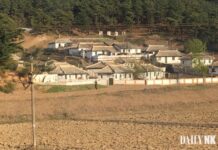Failures of central rationing and equipment distribution to the military have
resulted in exacerbated disparities from region to region.
According to one Daily NK source, a quick
glance at a soldier’s uniform is sufficient to predict his or her region, or even unit.
The
source from the port city of Chongjin in North Hamkyung Province told Daily NK
on July 17th, “Soldiers get very uncomfortable because they are not getting the
appropriate uniforms for each season. That’s why fabric for military uniforms sells so well in the jangmadang [market].”
“These
uniforms make the soldiers look terrible. You wouldn’t know from looking at some of them whether they were kotjebi [homeless orphans] or members of the
military,” he remarked. “Nowadays, you even need money if you want to wear the
right uniform and do your military duty properly.”
In
principle, Chosun People’s Army (KPA) soldiers should be provided with two sets
of both summer and winter uniforms, in addition to essential toiletries, socks,
and undergarments. However, this stopped happening regularly during the Arduous
March of the 1990s, when the distribution of most types of rations ceased.
According
to the source, this state of affairs led some ordinary soldiers and most ranking
officers to go and buy the fabric to make uniforms for themselves. Of course, poorer
soldiers were obliged to either wear whatever they were given, or resort to
stealing.
This
situation, which continues today, created a niche market for the fabrics to make
military uniforms. According to the Daily NK source, the material for a
basic uniform costs 10-20 USD (at a black market exchange rate of 7,500 KPW/1
USD), while the material for ranking officers (unit commanders and higher) runs
at about 100 USD.
The
fabric used to make uniforms differs depending on rank. General uniforms are
made from Tetron, a polyester-rayon
blend that gives off a soft luster, whereas those of senior officers are made
from wool for a more refined look. Given that a kilogram of rice currently costs in the region of 5000 KPW, this means that even a general uniform can cost its wearer 15-30kg of rice.
Depending
on the region where a soldier is stationed, living conditions can vary
drastically. Border Guard units stationed areas near the Tumen and Amnok rivers
do relatively better, as do those with Escort Command and Capital Defense
Command in Pyongyang. The 4th Corps in South Hwanghae Province, 8th Corps in
North Pyongan Province, and 7th Corps in South Hamkyung Province are also relatively
desirable locations, as they are purported to come with better conditions.
“Parents
overwhelmingly prefer their offspring to be with the Border Guards,” the source
said. “This is generally because they can take bribes from smugglers and other
traders on the border and reap quite large sums of money. Within three years or
so they’ve got enough to get discharged, enter the Party, and build a life
for themselves.”
“Pyongyang
and parts of South Hwanghae Province have decent transportation and guarantee relatively
better living conditions, making parents feel relieved when their children are
stationed there,” he continued. “Some parents will present the Military
Mobilization Department [Military Manpower Administration in South Korea] with
bribes to get their children stationed in those areas.”
At
the other end of the spectrum are areas under the remit of the 2nd Corps in
North Hwanghae Province, and especially the 1st and 5th corps in Gangwon
Province, whose poor conditions have earned their members the name “Kotjebi Corps”, the source claimed.
Predictably, the
class stratum of regional placement within the military results in local spikes
in criminal activity by soldiers, Daily NK’s source revealed. For example, “The
night before the Party meeting to commemorate 20 years since the death of Kim
Il Sung, 3-4 soldiers from the 9th Corps in Chongjin assaulted a group of passing
soldiers and robbed them of the uniforms they were wearing and their personal
belongings.”
“The
Military Police has detain the offenders and placed them under interrogation,”
he reported. “Perpetrators usually admit to the crime, and will cite their desire for the victim’s uniform as the motivation.”


















